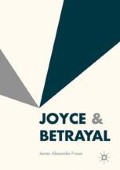Abstract
Moving away from an image of Stephen as a more or less simple transcription of Joyce’s own paranoia—a character who relives Joyce’s own experiences of betrayal and overcomes Joyce’s own hardships—this chapter suggests that Joyce is conscious from beginning to end of betrayal as a performance, a narrative into which Stephen willingly slots himself. While accepting the absurdities into which Stephen must move at times, Joyce allows betrayal a special position for its capacity to console, buoy up, and motivate Stephen as he progresses through a teleological narrative (the Künstlerroman) that he seems to feel pulling him along.
Access this chapter
Tax calculation will be finalised at checkout
Purchases are for personal use only
Notes
- 1.
Parnell’s fall from power was actually a fairly complex affair. The “priesthood” that Simon Dedalus maligns were not unanimous in their treatment of the divorce case. Regional, political, and personal discrepancies were rife and, even when the majority of churchmen did accept that Parnell’s position as de facto (political) leader of Catholic Ireland was untenable, relatively few “turned” on him. It is still difficult to produce a “neutral” account of Parnell’s fall, but it is generally agreed that Parnell could have saved himself (and ultimately his party) had he accepted political reality and taken a pragmatic vacation from frontline politics. His refusal to bend to traditional political wisdom had been the source of his unique and apparently inexplicable effectiveness, but it would also come to represent the major fault line of the dispute that dogged him until his death. The Parnellite position, vividly captured in Simon Dedalus’s litany of wrongs, would maintain the necessity of Parnell’s refusals; the anti-Parnellites argued instead that Parnell, despite his unarguable good work, had become an obstruction to the goals of the Irish people. The Parnellite irony kept alive throughout Joyce’s fiction and non-fiction is that without Parnell at the helm the Irish Parliamentary Party would fragment into ineffectualness. The fallow decades following Parnell’s death fuelled much of the Parnellite mourning Joyce captures in Simon Dedalus.
- 2.
- 3.
Saunders, Self-Impression, 299. This is the first place Saunders makes this claim, but it is the general thrust of his argument throughout chapters seven and eight of the book (291–370).
- 4.
Joyce develops this idea exhaustively—and in very different ways—in Exiles and Finnegans Wake.
- 5.
Ellmann, JJ, 725.
- 6.
Indeed, as a putatively selective medium (the novel does not pretend to detail a complete life, only representative or remarkable events), the novel in fact engineers significance through the act of selection.
- 7.
- 8.
Freud, “Family Romance,” 422.
- 9.
Parrinder, James Joyce, 87 (Parrinder 1984). To be clear, I am not suggesting that Joyce models his depiction of artistic overcoming on Freud’s theories. This is far too strong a claim given the evidence to hand. However, I am suggesting that reading Portrait with this framework in mind suggests strongly that Joyce consciously foregrounds a form of development as severance that shares helpful similarities to Freud’s descriptions of child development.
- 10.
- 11.
- 12.
We will see this in another, more anguished form in Exiles, where this good is ultimately called into question. Indeed, in Portrait this tendency of Stephen’s is kept at an ironic distance, even as it is embraced.
- 13.
Freud, “Family Romances,” 425.
- 14.
- 15.
Byrne, Silent Years, 63.
- 16.
Byrne, Silent Years, 64.
- 17.
This account is quoted and paraphrased from: JJ, 116.
- 18.
JJ, 116.
- 19.
This quotation comes from one of the additions that Joyce made to Herbert Gorman, James Joyce: A Definitive Biography (London: The Bodley Head, 1941). While it would be problematic to suggest that it therefore represents Joyce’s thoughts on the matter, we can at least be sure that it represented the way Joyce wished the matter to be seen by others.
- 20.
SL, 27.
- 21.
See Exiles: “the dedication of the master to the disciple who will betray him” (E, 24).
- 22.
- 23.
Hugh Kenner, “The Portrait in Perspective,” in Portrait of the Artist as a Young Man: A Casebook, ed. Mark Wollaeger (Oxford University Press, 2003). 29.
- 24.
Kenner, “The Portrait in Perspective,” 30–1.
- 25.
JJ, 116.
- 26.
See Hall, Shadowy Heroes (Hall 1980) for a discussion of this element of Irish writing.
- 27.
- 28.
Dominic Manganiello, Joyce’s Politics (London: Routledge, 1980), 94.
References
Adams, Robert Martin. 1962. Surface and Symbol: The Consistency of James Joyce’s “Ulysses”. Oxford: Oxford University Press.
Buchanan, Bradley W. 2010. Oedipus against Freud: Myth and the End(s) of Humanism in Twentieth-Century British Literature. London, ON: University of Toronto Press.
Byrne, John Francis. 1953. Silent Years: An Autobiography with Memoirs of James Joyce and our Ireland. New York: Farrar, Strauss, and Young.
Freud, Sigmund. 2006. The Penguin Freud Reader. Edited by Adam Phillips. London: Penguin.
Gorman, Herbert. 1941. James Joyce: A Definitive Biography. London: The Bodley Head.
Hall, Wayne E. 1980. Shadowy Heroes: Irish Literature in the 1890s. Syracuse: Syracuse University Press.
Manganiello, Dominic. 1980. Joyce’s Politics. London: Routledge.
Parrinder, Patrick. 1984. James Joyce. Cambridge: Cambridge University Press.
Said, Edward. 1984. The World, the Text, and the Critic. Cambridge, MA. Harvard University Press.
Saunders, Max. 2010. Self Impression: Life-Writing, Autobiografiction, and the Forms of Modern Fiction. Oxford: Oxford University Press.
Tóibín, Colm, ed. 2001. The Penguin Book of Irish Fiction. London: Penguin.
Author information
Authors and Affiliations
Copyright information
© 2016 The Author(s)
About this chapter
Cite this chapter
Fraser, J.A. (2016). “Boyhood” as “Death”: Betrayal in A Portrait of the Artist as a Young Man . In: Joyce & Betrayal. Palgrave Macmillan, London. https://doi.org/10.1057/978-1-137-59588-1_3
Download citation
DOI: https://doi.org/10.1057/978-1-137-59588-1_3
Published:
Publisher Name: Palgrave Macmillan, London
Print ISBN: 978-1-137-59587-4
Online ISBN: 978-1-137-59588-1
eBook Packages: Literature, Cultural and Media StudiesLiterature, Cultural and Media Studies (R0)

